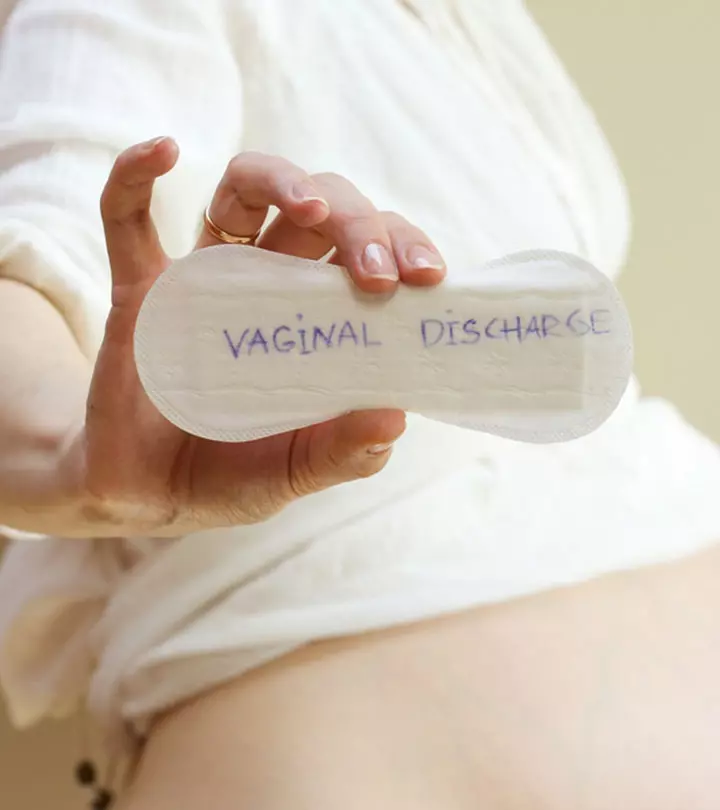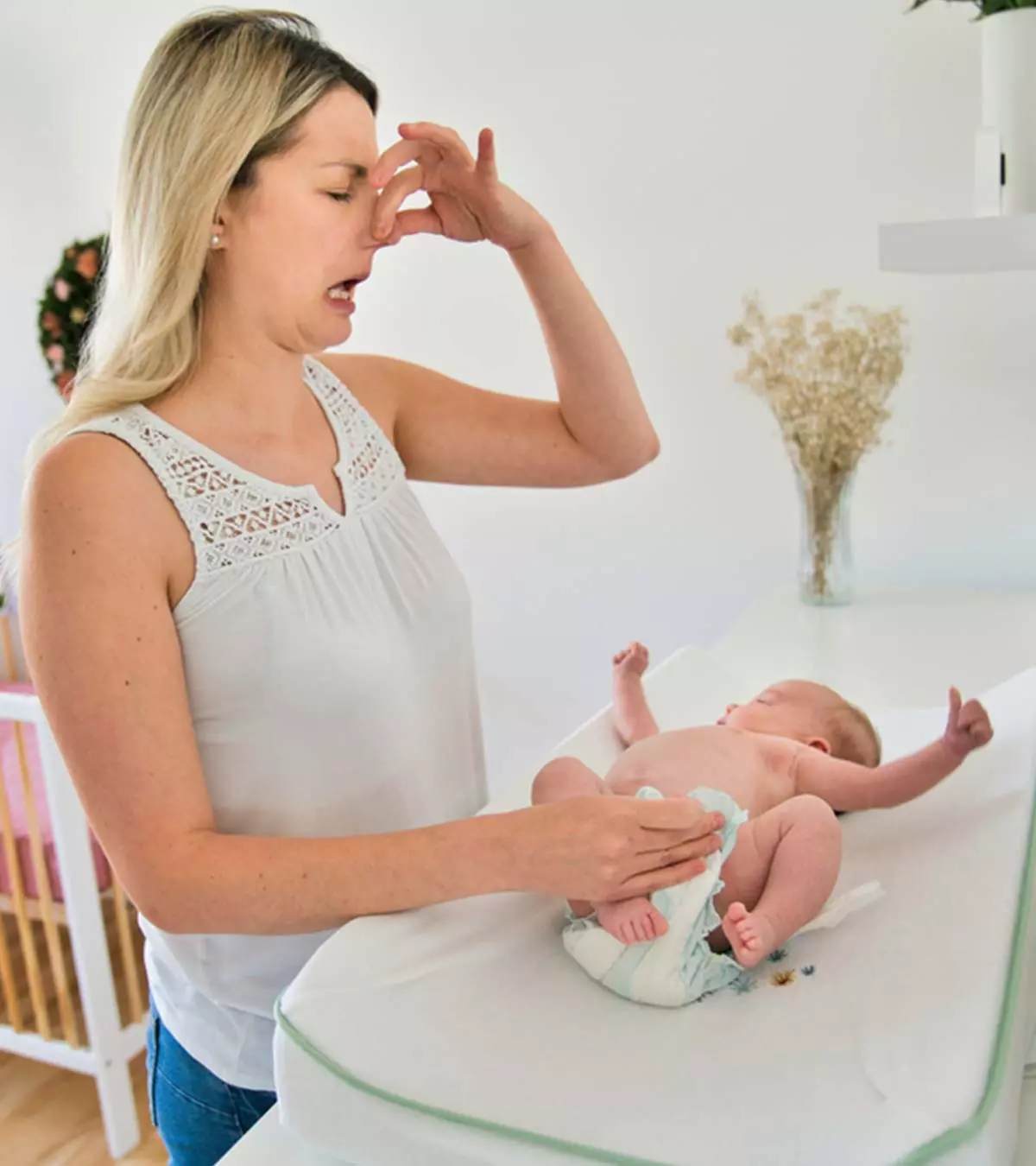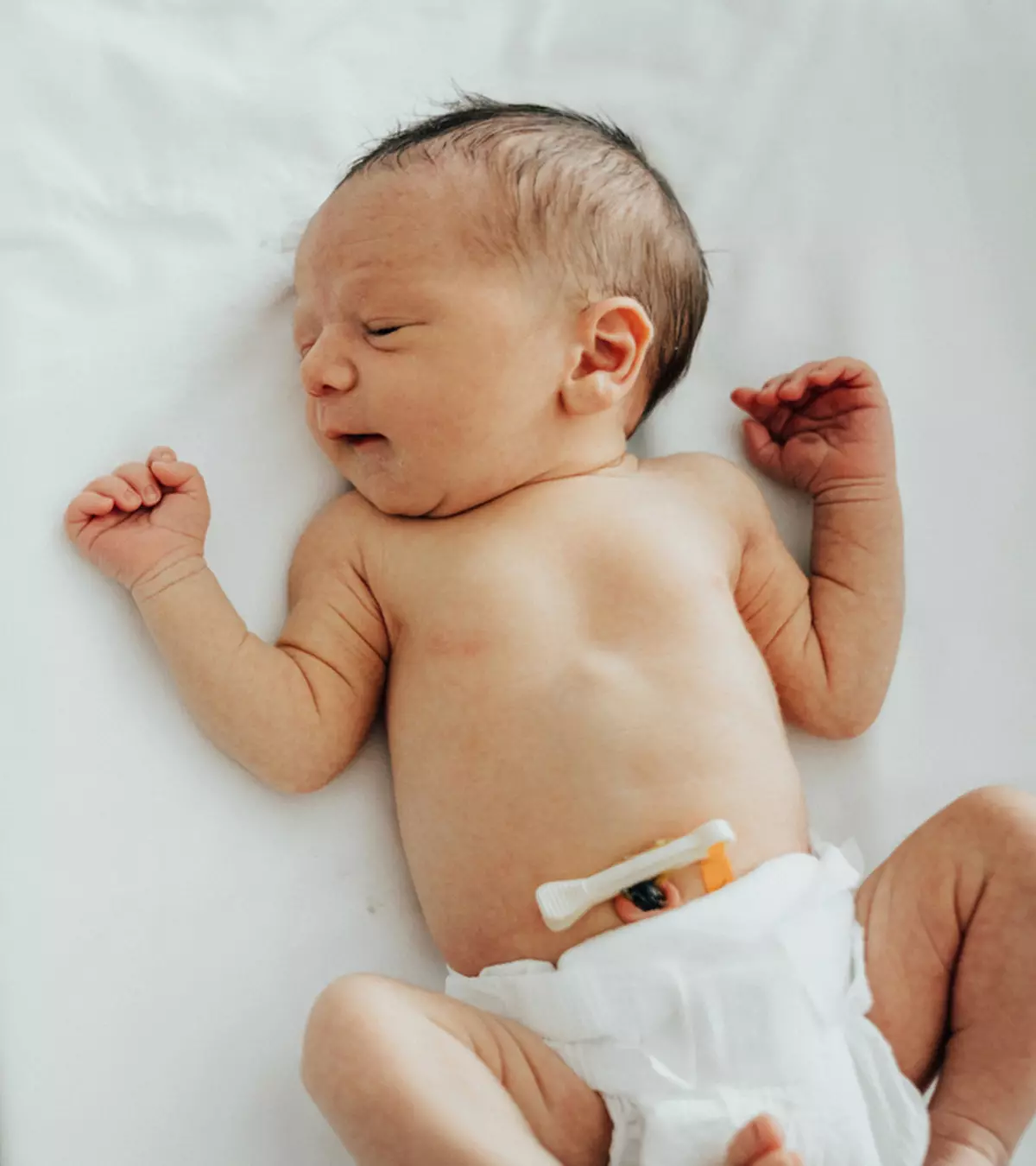
Image: iStock

Umbilical cord infection, umbilical stump infection, or omphalitis is a bacterial infection in babies. It affects the umbilical stump and happens if it is not managed properly. This infection is a medical emergency as the bacteria easily spreads around the navel. Nearly one in 200 newborns are affected by omphalitis (1).
Omphalitis presents itself through superficial cellulitis (bacterial skin infection). An untreated stump infection may spread to the entire abdominal wall, leading to sepsis or other life-threatening conditions.
Proper care of the umbilical cord stump is crucial to prevent infections that could pose serious health risks to newborns. Read on to know more about umbilical stump infection in babies, its causes, risk factors, symptoms, treatment, and prevention.
Key Pointers
- Omphalitis or umbilical cord infection affects the umbilical cord stump in babies.
- Low birth weight or premature rupture of membranes can increase the risk of omphalitis.
- If you notice fever or lethargy with blisters and sores in the baby’s umbilical area, contact your doctor.
- Cleaning the umbilical area, avoiding tight clothes, and other preventative measures as you read along.
Causes Of Omphalitis
Umbilical cord infection can be caused by anaerobic and aerobic bacteria (2). An umbilical stump is a wound where the tissue undergoes devitalization (necrosis), making it a suitable medium for bacterial growth. Bacteria from the skin can invade the stump and cause omphalitis (3).
Group B streptococci, S.aureus, Klebsiella, and E.coli are common microorganisms causing umbilical cord infections. Umbilical stumps can also get contaminated with C.tetani, especially in the first three days of life.
Sometimes, omphalitis can be the initial presentation of neutrophiliA type of white blood cell produced in the bone marrow that is essential for the immunity. disorders such as congenital neutropeniaiA birth disorder characterized by insufficient levels of neutrophils required for immunity. and neonatal alloimmune neutropeniaiA lethal disorder where maternal antibodies attack the fetus’ neutrophil cells. in babies. In such cases, neonates may also develop sepsis, meningitis, pneumonia, and cutaneous infections along with omphalitis.
 Did you know?
Did you know?Risk Factors For Omphalitis In Babies
The following factors may increase the risk for umbilical cord infection in babies (2).
- Premature rupture of membranes
- Umbilical cord catheterization
- Septic delivery (non-sterile delivery) and maternal infections
- Low birth weight

The following anatomical abnormalities can also increase the risk for omphalitis in neonates:
- Patent urachus is the remnant of the channel between the belly button (umbilicus) and bladder
- A urachal cyst is a sac-like tissue in the urachus that connects the umbilical cord and bladder
- Omphalomesenteric duct remnants
The application of unhygienic cord-cutting or clamping practices and the use of non-sterile instruments could increase the risk of cord infection in babies. The risk for cord infection reduces as the umbilical wound heals and the stump falls off.
 Quick fact
Quick factSigns And Symptoms Of Omphalitis
The following signs and symptoms may indicate umbilical cord infection in babies (1).
- Bleeding from the umbilical stump
- Erythema (red skin) around the navel
- Small bleeding or drops of blood leaking from the umbilical stump
- Blisters, sores, or pimples near the umbilical area
- Umbilical stump is not dry and clean even after following cord care measures for three or more days
- The cord is not fallen off beyond six weeks
- Pieces of red tissue are visible inside the navel
- Pus or cloudy discharge from the umbilicus
- Foul-smelling yellow discharge
- Inflammation and tenderness in the umbilical area
Serious infections can cause systemic signs that require immediate medical care (1).
- Fever
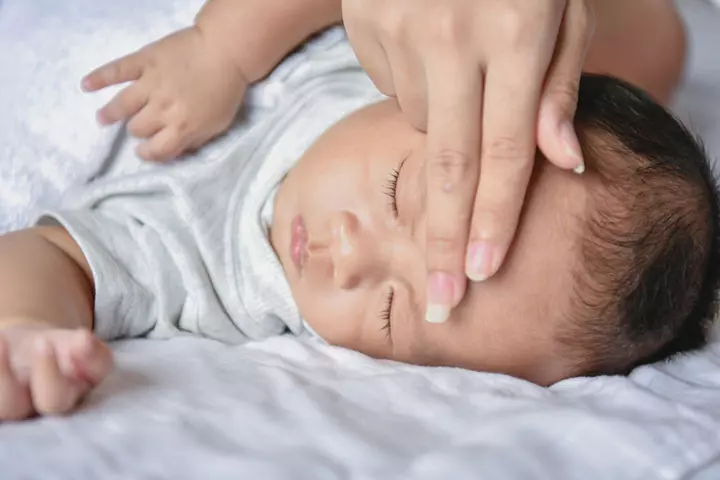
- Lethargy
- Poor or refusal to feeding
- Poor muscle tone (floppiness)
- Inflammation, redness, and tenderness around the navel
Do not give any fever medications to newborns without a prescription. Fever in the neonatal period should be treated with prescribed medicines only.
How To Prevent Omphalitis?
Appropriate care of the baby’s stump before and after it falls off helps prevent omphalitis in many cases.
The first thing you should do in cord care is never to remove the cord with your hands. Let it fall on its own, even if it is about to fall. Ensure proper hygiene and clean your hands with soap and water before touching the umbilical area of your newborn.
The following tips are usually recommended for cord care (4).
- Clean the umbilical area: You may gently clean the umbilical area twice a day. Rubbing with alcohol is not recommended by many experts since it may interfere with healing. You may use a wet cotton swab or moist cloth to clean the belly button. Secretions may ooze from the umbilicus for several days after the cord falls off. Clear and blood-tinged secretions are normal, and it stops eventually.
- Apply antibiotic ointment: Antibiotic ointments are recommended if pus is present. You may apply very little antibiotic ointment in the navel area after cleaning as per doctors’ recommendations.
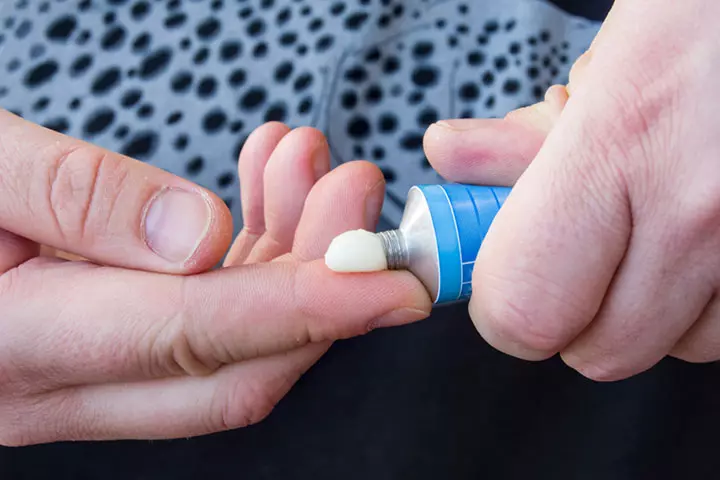
- Avoid tub baths: Avoid soaking the baby in bathwater or tub baths until the cord falls off and heals well. You may wipe your baby with a moist cloth or sponge. Avoid the use of talc or other baby powders on the cord after cleaning your baby.
- Fold diapers: Tie the diapers below the belly button and fold the elastic if required to allow air circulation. This may also help prevent skin irritation from wet or soiled diapers.
- Avoid tight clothing: Avoid tight clothing across the umbilical cord. Loose-fitting baby clothes made of breathable materials help to maintain air circulation in the umbilical area. This also allows the stump to fall off naturally.
Usually, the discharge and pus in the umbilicus disappear within two to three days of treatment. The navel area becomes dry and healed within a week in most babies. You may seek medical care if the umbilical healing is prolonged after the stump falls off.
When To See A Doctor?
Seek medical care if your baby has any symptoms of umbilical cord infection. Immediate medical care is also needed if the baby has umbilical bleeding for more than ten minutes. Furthermore, medical care is essential if belly button bleeding in newborns is noticed, even for shorter durations, for more than three days (1).
Never hesitate to talk to the healthcare provider if your newborn looks ill or you are concerned that the child needs to be evaluated. You may also contact the doctor during office hours to clarify any queries and to know about umbilical cord care.
Diagnosis Of Omphalitis
After physical examination, the following tests are ordered for suspected omphalitis cases (2).
- Laboratory tests including complete blood count and culture are ordered for all babies with suspected omphalitis
- Culture of purulent discharge from the umbilical stump is often obtained before initiating treatment
Complete neonatal septic workup is required for babies with systemic symptoms. This may include:
- Chest X-ray
- Urinalysis
- Urine culture

- Cerebrospinal fluid culture
Detailed blood counts and blood tests are done since omphalitisis closely linked to leukocyte adhesion disordersiA rare hereditary immune disorder that causes failure of the immune system cells to heal an infection or tissue injury. (LAD)
. Usually, leukocytes should migrate to the umbilical stump and fight infections. Thus, it is essential to look for any defects or inability in immune functions in babies with umbilical cord infections.
Treatment For Omphalitis
Treatment for omphalitis usually begins with broad-spectrum antibiotics to cover both gram-positive and gram-negative bacteria. Any of the following antibiotics are given according to the cause (2).
- Aminoglycosides and antistaphylococcal penicillin are prescribed for initial treatment.
- Vancomycin is used for methicillin-resistant staphylococcus aureus (MRSA) infection.
- Metronidazole or clindamycin is given to treat anaerobic bacteriaiA type of bacteria that does not require oxygen to grow and may die upon exposure. if the baby has foul-smelling umbilical discharge.
The duration and dose of antibiotic therapy may depend on clinical response and complications. Uncomplicated omphalitis is usually treated with parenteral (IV) antibiotics for ten days and switched to oral therapy. Doctors may switch parenteral therapy to oral therapy based on culture results and improvement.
Complications Of Umbilical Cord Infection
Sepsis is the most common complication of cord infection. If left untreated, sepsis can lead to septic shock and death. Other rare complications may include (2):
- PeritonitisiAn inflammation of the inner lining of the belly, the peritoneum, due to infection, surgery, or underlying condition.
- Liver abscess
- Intestinal gangrene
- Septic umbilical arteritis
- Portal vein thrombosis
- Small bowel evisceration
- Necrotizing fasciitis
Necrotizing fasciitisiA rare fatal bacterial infection from a bite, cut, or wound, causing pain, fever, diarrhea, and dizziness. with omphalitis has been associated with mortality. Rapid progression of cord infection, systemic toxicity signs, and no clinical improvement for 24 to 48 hours despite intravenous antibiotic administration are common indications of necrotizing fasciitis in babies with omphalitis. Doctors may recommend prompt surgical care for debridementiA removal process of damaged tissues while treating a wound. of umbilical structures in such cases.
How Long Does It Take To Recover?

Babies with uncomplicated omphalitis usually have favorable outcomes. Most babies recover within a couple of weeks of antibiotic therapy if it is initiated in the early stages of cord infection. Hospitalization is required until intravenous medications are needed.
There is a 7-15% mortality rate in babies who develop complications other than necrotizing fasciitis. Babies with necrotizing fasciitis or omphalitis may have a higher risk for mortality of about 38 to 87%. Although prematurity, low birth weight, and septic delivery increase the risk for poor prognosis, the data is limited regarding the role of these factors in the mortality rate (2).
Frequently Asked Questions
1. How common is umbilical cord infection?
The umbilical cord infection or omphalitis is an uncommon condition. It might occur for every one in 200 newborns (2).
2. Is it normal to see a little pus after the umbilical cord falls off?
A small amount of pus may be present after the umbilical cord is cut off. The pus may dry and may not be seen after two or three days. However, if there is excessive pus release and other symptoms such as redness around the navel area, fever, or abnormal behavior of the baby, consult your doctor for prompt medical attention (2).
3. Are there any home remedies or over-the-counter treatments for umbilical cord infections?
You may care for an umbilical cord infection at home by cleaning the area surrounding the navel region and applying pediatrician-approved antibiotic ointments. In addition, keeping the belly button and the surrounding area dry might help in the healing process (1).
Adequate stump care before and after the umbilical cord falls off could help prevent umbilical stump infections in most babies. However, avoiding swabbing the stump and letting the cord fall off naturally is recommended to reduce the risk of infections. Care must also be taken not to apply anything to the umbilical area and to keep it always dry. Timely medical care could prevent complications and worsening of the umbilical cord infection. Seek medical attention if the cord has not fallen off within the recommended time or if there is any sign of infection in the umbilical area, such as discharge, swelling, or redness.
Infographic: What Factors Increase The Risk Of Omphalitis?
Umbilical cord infection or omphalitis is a bacterial infection in babies for several reasons, including improper management or handling of the umbilical cord. Check out the infographic below to learn about the factors that increase the risk of omphalitis in babies.
Some thing wrong with infographic shortcode. please verify shortcode syntaxLearn about the signs and symptoms of potential umbilical cord infection in babies from a medical expert and know when to seek medical attention
References
- Umbilical Cord Symptoms; Seattle Children’s Hospital
- Omphalitis; U.S. National Library of Medicine
- Mohamed A Baky Fahmy; (2018); Omphalitis
- Umbilical Cord Infection (Newborns); Fairview
Community Experiences
Join the conversation and become a part of our nurturing community! Share your stories, experiences, and insights to connect with fellow parents.
Read full bio of Dr. Neema Shrestha
Read full bio of Dr Bisny T. Joseph
Read full bio of Rohit Garoo
Read full bio of Vidya Tadapatri















